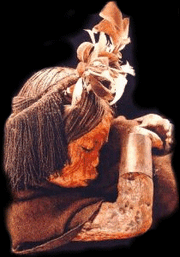| Contents |
|---|
| Biography
References |
| The El Plomo Boy | |
| Biographical Information | |
|---|---|
| Name(s) | The El Plomo Boy |
| Age | 8 |
| Sex | Male |
| Status | High Status |
| Height | Unspecified |
| Source | |
| Culture | Inca |
| Date(s) | Approx. 500 years ago |
| Site | Cerro El Plomo |
| Current Location | |
| Location | National Museum of Natural History, Santiago Chile |
| Catalog # | Unknown |
Biography
The El Plomo boy is an Incan mummy discovered in 1954 by a group of climbers at the summit of Cerro El Plomo inChile. The mummy is approximately 500 years old, with the boy being approximately 5-8 at the time of death. The cold climate and minimal rainfaill atop the mountain allowed the mummy to remain remarkably well preserved. The mummy was well dressed in Incan textiles and jewelry, and found with a gold llama, a silver doll, and pouches of his baby teeth and nail clippings. In addition, his hair was braided into 200 intricate strands. The El Plomo boy was the first mummy discovered in a series that would later reveal the Incan practise of sacrificing children to the Gods that they believed to control water. He is currently stored in Chile's National Museum of Natural History in Santiago.

The El Plomo is remarkably well preserved.
The Andean mountains were a key part of the Incan kingdom, which stretched from Equador to southern Chile. The Inca believed the summit of a mountain served as a ladder to heaven, making these sites important sacred spaces. Several mountains,including Cerro El Plomo, Sara Sara, and Llullaillaco, were the site of an Incan ritual known as Capa Cocha. Other mummies found on these peaks include La Doncella, Sarita, Juanita, the Aconcagua boy, and the El Niño boy (for further information on these see the 'The Children of Llullaillaco' entry).

Horizon Ice Mummies - Frozen In Heaven
See 12:20 for discussion of the El Plomo Boy.
Human sacrifice was not common amongst the Inca, but the need to appease mountain Gods controlling rain and water was believed to be critical to the survival of the Incan people. Accounts of Capa Cocha first appeared in Spanish chronicles, though it was ethnocentrically depicted as a bloody and savage ritual. During the Capa Cocha ritual a child would be brought to the empire's capital of Cuzco, blessed by the emperor, then paraded through the kingdom in a ritual procession until they reached the top of the mountain on which they were sacrificed and buried. Children selected for sacrifice were considered pure and perfect, and it was believed they would be deified in death. Analysis of stomach and intestinal contents of some of these mummies indicates that they were sedated before death with the use of coca leaves and chica, a maize beer. In the case of the El Plomo boy, his peacful expression indicates he passed peacefully from sleep to death. P.D. Horn, from the University of Toronto's Anthropology Department, noted in 1982 the distinctive red and yellow bands painted across the child's face composed of iron ochre and arsenic sulphides mixed with animal fats, respectively. The distinctive smell of the mummy, caused by changes in body fat, attests to its good condition.
References
Bos, C. (2014). El Plomo mummy: Story of a child mummy. Retrieved from http://www.awesomestories.com/asset/view/El-Plomo-Mummy-Story-of-a-Child-Mummy
Clark, L. (1998). Ice mummies of the Inca. Retrieved from http://www.pbs.org/wgbh/nova/ancient/ice-mummies-inca.html
Haines, T., (Producer). (1997). Ice mummies: Frozen in heaven [Motion picture]. United Kingdom: BBC.
Horn, P. D. (1996). The prince of El Plomo: a frozen treasure. In K. Spindler (Ed.), Human mummies: a global survey of their status and the techniques of conservation (pp.153-157). Vienna, Austria: Springer Vienna.
Lane, K. (2011). Inca. In T. Insoll (Ed.), The oxford handbook of the archeology of ritual and religion (pp. 571-584). Oxford: Oxford University Press.
Reinhard, J., & Constanza, C. (2010). Inca rituals and sacred mountains. Los Angeles: Cotsen Institute of Archaeology Press.